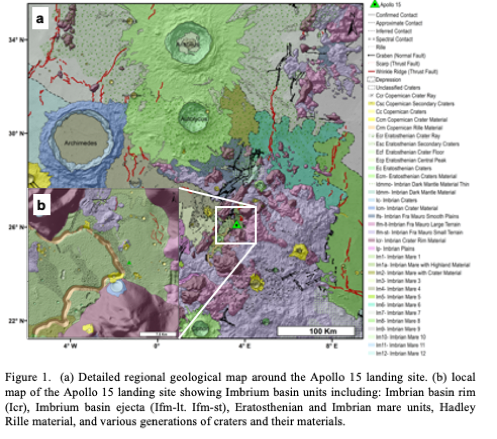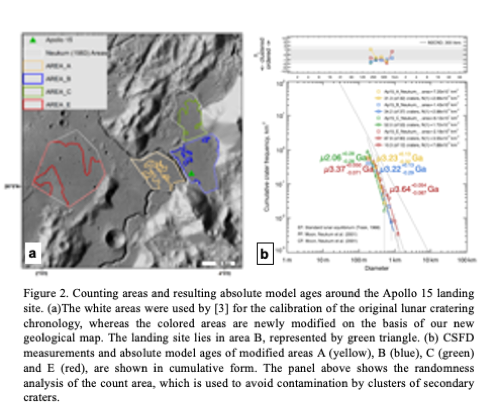Detailed Geological Studies and Absolute Model Ages of the Apollo 15 Landing Site
- Institut für Planetologie, Westfälische Wilhelms-Universität, Wilhelm-Klemm-Str. 10, 48149, Münster, Germany
Introduction: The Apollo 15 landing site is one of the calibration points for the lunar cratering chronology, which compares crater size-frequency distribution (CSFD) measurements to lunar sample ages [e.g., 1-6]. Following our series of studies [7-10] of the lunar chronology using recent lunar mission and sample analysis data [11-15], we produced new detailed geological maps of Apollo 15 landing site and used these to define homogeneous areas for measuring CSFDs of the geological units where samples were collected.
Methods: We used LROC Wide Angle (WAC; 100 m/pixel) and Narrow Angle Camera (NAC; ~0.5 m/pixel) data [11] with incidence angles between 55-80°, SELENE (Kaguya) image data, a LOLA/SELENE merged digital elevation model (DEM) [12], Clementine [13] and Kaguya Multiband Imager (MI) data [16] for geological mapping. The CSFDs were measured on the identified geological units by using CraterTools [17] in ArcGIS, and the gained values were plotted in Craterstats [18] using pseudolog binning, in cumulative and relative plot. Randomness analyses [19] were used to identify and avoid secondary crater chains and clusters. The new N(1) values will be correlated with recently determined sample ages [20] to obtain new calibration points.

Geological Events: The Apollo 15 landing site lies east of the Hadley rille near the rim of the Imbrium basin. The mapped area contains the Imbrium basin rim (Icr), Imbrium basin ejecta (Ifm-lt, Ifm-st, and Ifs, mapped on the basis of topographical differences), and Imbrian plains (Ip). The valley is filled with various mare units belong to Eratosthenian- and Imbrian-aged mare units [21], which are resurfaced by the ray and secondary crater materials from both Autolycus and Aristillus craters [22,23]. The network of rilles in vicinity belongs to different ages.

CSFD Measurements: The new geological map was used to modified Neukum’s (1983) selected count areas A, B, C, and E, and to measure CSFDs in these areas using LRO and Kaguya image data. Areas A and B lie on the same mare unit (Im1) and have N(1) values of 2.99x10-3 km-2 and 2.98x10-3 km-2, The landing site lies in Area B. Area C consists of various geological units and we gain N(1) value of 1.72x10-3 km-2, which may represent young crater material. Similarly, Area E also has two N(1) values of 3.55x10-3 km-2 and 7.88x10-3 km-2, representing two mare units.
Neukum (1983)[3] used an N(1) value of 3.2±1.1x10-3 km-2 measured on Area B, and sample age ~3.28 Ga for the lunar cratering chronology calibration [3]. The recent sample analyses determined ages of ~3.26 Ga for olivine normative basalts and ~3.35 Ga for quartz normative basalts [20].
Acknowledgements: WI and HH were funded by the German Research Foundation (Deutsche Forschungsgemeinschaft SFB-TRR170, subproject A2) and CvdB was supported by EU H2020 project #776276, PLANMAP
References: [1] Hartmann (1970) Icarus 13, 299-301. [2] Neukum et al. (1975) The Moon 12, 201-229. [3] Neukum (1983) NASA TM-77558. [4] Neukum et al. (2001) Space Sci. Rev. 96, 55-86. [5] Robbins (2014) EPSL 403, 188-198. [6] Stöffler et al. (2006) Rev. Min. Geochem. 60, 519-596. [7] Iqbal et al (2019) Icarus 333, 528-547. [8] Iqbal et al (2018) LPSC 49, 1002. [9] Iqbal et al (2019) LPSC 50, 1005. [10] Hiesinger et al (2020) LPSC 51, this conference [11] Robinson et al (2010) Space Sci. Rev. 150, 81-124. [12] Barker et al. (2016) Icarus 273, 346-355. [13] Pieters et al. (1994) Science 266, 1844-1848. [14] Ohtake et al (2013) Icarus 226, 364-374. [15] Nemchin et al (2018) LPSC 49, 1936. [16] Lemelin et al (2016) LPSC 47, 2994. [17] Kneissl et al. (2011). PSS 59, 1243-1254. [18] Michael et al. (2016) Icarus 277, 279-285. [19] Michael et al. (2012) Icarus 218, 169-177. [20] Snape et al (2019) GCA. 266, 29-53. [21] Hiesinger et al (2000) JGR 105, 29239-29275. [22] Howard (1971) USGS, I-723 [23] Carr et al (1971) USGS, I-723.
How to cite: Iqbal, W., van der Bogert, C., and Hiesinger, H.: Detailed Geological Studies and Absolute Model Ages of the Apollo 15 Landing Site, Europlanet Science Congress 2020, online, 21 Sep–9 Oct 2020, EPSC2020-1091, https://doi.org/10.5194/epsc2020-1091, 2020.

